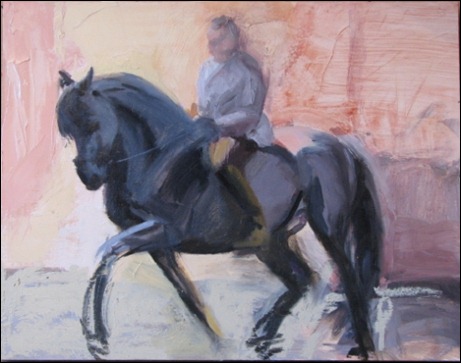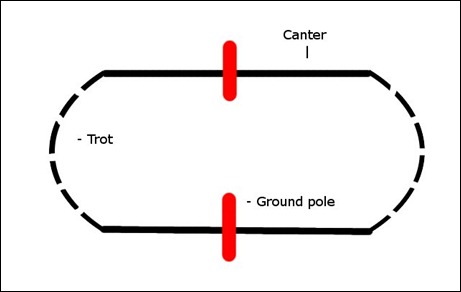
Helen Langehanenberg, a German Grand Prix dressage rider talks about using transitions on a 20m circle to create submission and cooperation in this useful article from Equi Search.
With a young horse, I might do one round of trot and then one round canter. With a more educated horse, I will do the transitions more frequently. During these transitions, I improve my horse's reactions so we can be very coordinated.
When the horse starts to warm up, I ride the figure-eight. You don't want the work to be boring. When you do different things, the horse finds the work fun, and he concentrates more on you. In the figure-of-eight, I give a little half halt each time I change the rein to I make sure I can feel my horse's balancing reaction….
What you want to achieve in a trot-walk-trot exercise:
- As you do the downward transition from trot to walk, you close the horse's frame and bring his hind legs under his centre of gravity so he engages and carries more weight behind.
- Then, when your horse is engaged, you go directly to trot again. In that upward transition, you want to open the neck a bit, but keep the hind-leg carriage you had in the walk.
Another exercise that uses transitions to help the horse pay attention to the aid is an 10m wide oval with two jump poles on the ground. Riding in a trot on short ends, and cantering on long ends over the poles placed in the middle of the long sides, you use the up down transition to get the horse listening and sharp off the leg and the pole for balance.
You can make the oval larger to make it easier ~ the bigger the oval, the easier the exercise will be, the smaller, the harder; however, there should at least be room for 5/6 strides of canter and 3/4 strides of trot.
Like so:

Canadian show jumper Margie Gayford uses this canter/trot exercise as a warm up for jumping. Margie is not only a Grand Prix Show Jumper, but also a sought-after level 3 coach and clinician. You can see the exercise working in the first 3 minutes of this video:
Another way to create looseness in the back is to stretch your horse often in trot and canter. You can do that by releasing the horse’s head and allowing them reach down low. Don’t forget to secure your seat by making sure your shoulders are behind your hip bones, because if you are tipping forwards your horse might be encouraged to put in a playful buck!
See ya!
bonita
Credits & Resources:
- Horse Junkies United: Lesson with a Pro – Show jumping with Margie Gayford
- Equi Search: Develop the Quality of Submission in Your Horse







